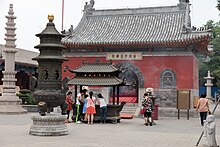
Xuanzang, born Chen Hui or Chen Yi, also known by his Sanskrit Dharma name Mokṣadeva, was a 7th-century Chinese Buddhist monk, scholar, traveller, and translator. He is known for the epoch-making contributions to Chinese Buddhism, the travelogue of his journey to India in 629–645, his efforts to bring at least 657 Indian texts to China, and his translations of some of these texts. He was only able to translate 75 distinct sections of a total of 1335 chapters, but his translations included some of the most important Mahayana scriptures.
White Horse Temple is a Buddhist temple in Luoyang, Henan that, according to tradition, is the first Buddhist temple in China, having been first established in 68 AD under the patronage of Emperor Ming in the Eastern Han dynasty.
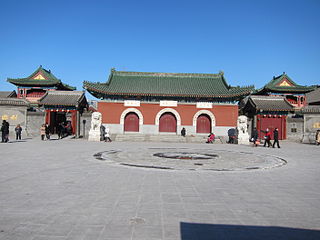
The Temple of Great Compassion or Dabei Yuan is a Chan Buddhist temple in Tianjin, China.

The Longxing Monastery or Longxing Temple is an ancient Buddhist monastery located in the town of Zhengding in Hebei Province, China, approximately 15 kilometres (9.3 mi) north of the provincial capital of Shijiazhuang. It has been referred to as the "Best Temple south of Beijing".

The Zhihua Temple is a Ming dynasty-era Buddhist temple in Beijing, China. It is located in the Lumicang (禄米仓) hutong, in the Chaoyangmen area of Dongcheng District, within the Second Ring Road to the north of Jinbaojie Street, west of the Yabaolu area. The temple was built in 1443 at the order of Wang Zhen, a powerful eunuch in the Rites Supervising Office of the court of the Zhengtong Emperor.
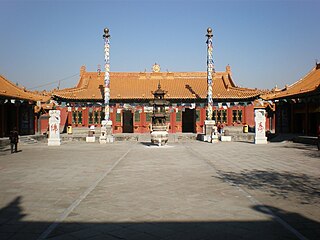
Dazhao Temple, also known as the Hongci or Wuliang Temple and as the Ih Juu, is a Tibetan Buddhist monastery of the Gelugpa order in the city of Hohhot in Inner Mongolia in North China. It is the oldest and largest temple in the city and is located West of Danan Street in the Yuquan District.

The Fayuan Temple, situated in the southwest quarter of central Beijing, is one of the city's oldest and most renowned Buddhist temples.

The Dajue Temple is a Buddhist temple located in the Haidian District of western Beijing, China. It was founded in the 11th century, and the current temple dates to a reconstruction in the 15th century during the Ming Dynasty. It contains three main halls, a gate, a pagoda and various side halls.

The Xiantong Temple is a Buddhist temple located in Taihuai Town of Wutai County, Shanxi, China. The temple covers a total area of about 80,000 square metres (860,000 sq ft), it preserves the basic architectural pattern of the Ming and Qing dynasties (1368–1912). The temple has over 400 buildings and the seven main halls along the central axis are the Guanyin Hall, Great Manjusri Hall, Great Buddha Hall, Amitaba Hall, Qianbo Hall, Copper Hall and Buddhist Texts Library. Mount Wutai has 47 Buddhist temples, it is the largest Buddhist complex in China, Xiantong Temple is the largest one with the longest history.
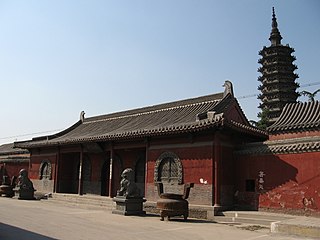
Linji Temple is a Buddhist temple located in Zhengding Town of Zhengding County, Hebei, China. In the mid-Tang dynasty (618–907), Linji Yixuan founded the Linji school, which eventually became one of the five major schools of Buddhism in China. In the Song dynasty (960–1276), two Japanese monks Eisai and Shuniyo introduced Linji school to Japan. Linji Temple is the cradle of Linji (Rinzai) school of both Chinese and Japanese Buddhism. The temple was added to National Key Buddhist Temples in Han Chinese Area's list in 1983. The eldest thing in the temple is the Chengling Stupa, which still preserves the architectural style of the Liao and Jin dynasties (916–1234).

Kaiyuan Temple is a Buddhist temple located in Xiangqiao District of Chaozhou, Guangdong, China.
Qianming Temple is a Buddhist temple located in Nanming District of Guizhou, Guiyang, China.

Caotang Temple is a Buddhist temple located on the north hillside of Mount Guifeng, in Huyi District of Xi'an, Shaanxi, China.

Zhiyuan Temple is a Buddhist temple located on Mount Jiuhua, in Qingyang County, Anhui, China. Alongside Ganlu Temple, Baisui Palace and Dongyan Chan Temple are honoured as the "Four Buddhist Temple on Mount Jiuhua".
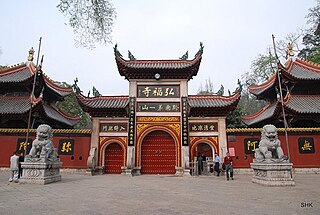
Hongfu Temple is a Buddhist temple located on Mount Qianling, in Yunyan District of Guiyang, Guizhou, China. Hongfu Temple and Qixia Temple are collectively known as the "Two Attractions in Guiyang".

Wenshu Temple, or Wenshu Monastery, is a Buddhist temple located in Qingyang, Chengdu, Sichuan, China.

Lingguang Temple is a Buddhist temple located on the east hillside of Mount Cuiwei (翠微山), in the Shijingshan District of Beijing. The temple is renowned for its collection of the tooth relic of the Buddha.

Huayan Temple or Huayan Monastery is a Buddhist temple located in Datong, Shanxi, China.
Sanzu Temple is a Buddhist temple located on Mount Tianzhu, in Qianshan, Anhui, China. Originally built in 505 in the Northern and Southern dynasties (420–589), the temple has a history of over 1550 years, but it was destroyed and rebuilt many times because of war and natural disasters. The present version was completed in 1944.

Xingguo Temple is a Buddhist temple located in Zhangqiu District of Jinan, Shandong.
